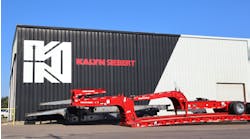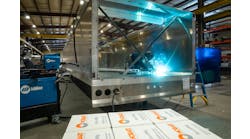FABTECH attendees were the first to experience a new collaborative robot welder, the Vectis Cobot Welding Tool—and, coincidentally, one of the demonstration samples came from a trailer manufacturer, explained Josh Pawley, director of business development and co-founder of robotic welding specialist Vectis Automation.
“We brought our system in, and I asked ‘what’s your least favorite part of the run today?’ ” Pawley said. “They had to do 300 of these little dinky brackets. Robots are always greeted with a little bit of skepticism in the shop, but what a cobot does is free up that welder to go work on the rest of the trailer. Skilled welders are in short supply, so let them work on skilled welding.”
Indeed, Vectis is Latin for leverage. The company’s pitch is that leverage is now extended to manufacturers seeking a low-risk, low-cost, easy-to-use answer to increase welding productivity amid the ongoing shortage of skilled labor.
Simply, the Vectis Cobot Welding Tool helps manufacturers boost productivity by reducing the learning curve, deployment time, risk, and cost of robotic welding. Powered by Universal Robots’ UR10e collaborative robot, the Vectis Cobot Welding Tool is a portable, safe, versatile, and extremely easy-to-use solution that is even available as a low-risk, no-capital rent-to-own option, according to the company.
“We saw Universal Robots prevail as the undisputed leader in the cobot market, lowering automation barriers through ease of use and fast deployment,” Pawley said. “We wanted to build our cobot welder on this platform, providing the same user experience to welders that manufacturers in many other industry verticals now enjoy.”
The Vectis Cobot Welder is commonly 25-40% less expensive than the all-in cost of a small traditional robot welder, he added.
Users of the Vectis Cobot Welding Tool are typically set up entirely by the customer within a few hours of system arrival and welding within 10 minutes of setup—with no programming experience necessary. Vectis’ Let’s Weld Together intuitive programming interface is accessible directly through the UR cobot’s own teach pendant. Programs can be created, saved, and later recalled in order to handle the numerous part numbers typical for high mix/low volume shops.
The Vectis system comes with all hardware provided fully integrated onto a 3ft x 6ft mobile modular fixturing cart enabling metal fabricators to bring the cobot to the work, or the work to the cobot, with no anchoring or dedicated footprint required. The Vectis Cobot Welding Tool does not need three-phase power but runs off a 120V wall outlet, the welder can run on anything between 208V and 575V, including 240V single phase.
A key part of the Vectis process is collaboratively reviewing applications to provide insight on application viability and how to achieve success in production. The company also offers suggestions on any upstream fabrication issues and/or how it could be redesigned to make it more automation friendly.
Additionally, during production gaps in the weld shop, the cobot arm can be repurposed to other tasks.
For more information, visit universal-robots.com or vectisautomation.com.










